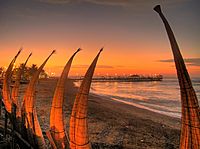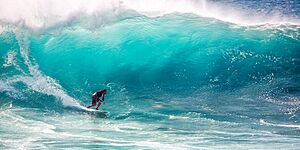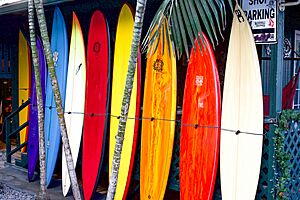History of surfing facts for kids
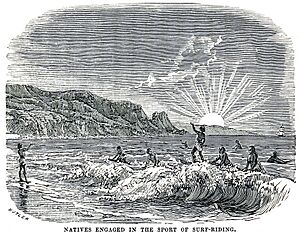
Surfing, the exciting sport of riding ocean waves, has probably been around for as long as people have been swimming in the ocean. The simplest form, bodysurfing, where you ride a wave with just your body, is likely the oldest way to catch a wave. Ancient sailors also learned to use wave energy with their early boats. In Peru, there's proof that people surfed on reed boats for fishing and fun as far back as 5,000 years ago! However, standing up on a surfboard, like we do today, was an idea developed by the Polynesians. Modern surfing as we know it comes directly from the surfers of ancient Hawaii.
Contents
- Surfing in Ancient Peru
- Surfing in West Africa
- Polynesian Surfing History
- Ancient Hawaiian Surfing
- Surfing After European Contact
- Surfing in North America
- Australian Surfing History
- Surfing in Great Britain
- Modern Surfing's Rise
- Professional Surfing
- Surfing Technology and Boards
- Big Wave Surfing
- Surfing for Fun and Meaning
- Surfing Without Ocean Waves
- See also
Surfing in Ancient Peru
Archaeologists have discovered that people in pre-Inca times, about three to five thousand years ago, rode on vessels using waves. The Moche culture used special boats called caballito de totora (which means "little horse of totora"). We have archaeological proof that these boats were used around 200 CE.
A Jesuit missionary named José de Acosta wrote about Inca surfing in his 1590 book. He described how people rode these boats. Even today, local fishermen still use Caballitos de Totora. Tourists can also ride them for fun.
Surfing in West Africa
People in West African countries like Ghana, Ivory Coast, Liberia, and Senegal, and also in western Central Africa (like Cameroon), learned to surf on their own. In the 1640s CE, Michael Hemmersam wrote about surfing in the Gold Coast. He said parents would "tie their children to boards and throw them into the water."
Later, in 1679 CE, Barbot described children in Elmina, Ghana, learning to swim. They used "bits of boards, or small bundles of rushes, fasten’d under their stomachs." This was a fun sight for people watching. In 1834, James Alexander saw boys in Accra, Ghana, swimming with light boards. They would wait for a wave and "come rolling like a cloud on top of it." He also heard that sharks sometimes "yam" (eat) them. In 1861, Thomas Hutchinson wrote about fishermen in southern Cameroon. They rode small dugouts, which were very short boats.
Polynesian Surfing History
Surfing, called heʻe nalu (wave sliding) in Hawaiian, was first written about by Joseph Banks. He was on James Cook's ship, HMS Endeavour, in Tahiti in 1769. He wrote that their main fun was riding an old canoe's stern. They would swim out to the waves, then one or two would get in. They would face the breaking wave and be carried to shore very fast.
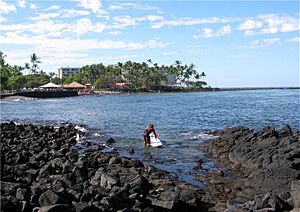
Surfing was a huge part of ancient Polynesian culture even before Europeans arrived. The chief, or Ali'i, was usually the best wave rider. He had the finest board made from the best wood. The ruling class had the best beaches and boards. Common people couldn't use the same beaches. However, they could earn respect by being good at riding waves.
In Tahiti and Samoa, surfing was a popular hobby. It was also part of warrior training. Warriors would paddle out to surf spots. European historians wrote that they spent many hours bravely paddling into big waves and riding them. Canoes often went with surfing groups. Men would switch between canoeing and paddling boards. After their fun, they would often catch fish. In Hawai'i, surfing became deeply connected to Hawaiian religion and way of life.
Other Europeans also wrote about and photographed Samoans surfing. They used planks and single canoe hulls. Samoans called surf riding fa'ase'e or se'egalu. Oral stories also say that surfing was done in Tonga. The late king Taufa'ahau Tupou IV became a surfing expert when he was young.
Ancient Hawaiian Surfing
Hawaiians called surfing heʻe nalu, meaning "wave sliding." Before entering the ocean, Hawaiians would pray to their gods for safety and strength. If the ocean wasn't cooperating, frustrated surfers would ask a kahuna (priest) for help. The priest would lead a prayer asking the gods for great waves. Before going into the water, the priest also helped surfers, mostly from the upper class, with a special ceremony to build a surfboard.
Hawaiians carefully chose one of three types of trees. These were the koa (Acacia koa), ʻulu (Artocarpus altilis), and wiliwili (Erythrina sandwicensis) trees. Once a tree was chosen, the surfer would dig it out. They would place fish in the hole as an offering to the gods. Skilled craftspeople in the community were then hired. They would shape, stain, and prepare the board.
There were three main board shapes: the ʻolo, kikoʻo, and the alaia. The ʻolo was thick in the middle and got thinner towards the edges. The kikoʻo was about 12 to 18 ft (0 to 10 m) long. It needed great skill to use. The alaia board was about 9 ft (5 m) long. It also needed great skill to ride and master. The most skilled surfers were often from the upper class. This included chiefs and warriors. They surfed the best waves on the island. These upper-class Hawaiians earned respect by mastering the waves.
Some ancient surfing spots that are still popular today include Kahaluʻu Bay and Holualoa Bay.
Surfing After European Contact
After Europeans arrived, Hawaiian culture was forced to change. Western diseases spread, and colonization began. Plantations were built, and people from other countries moved there. Local Hawaiians and workers from Asia were put to work on sugar plantations. Protestant missionaries tried to turn the population from their traditional beliefs to Christianity. Surfing was often seen as silly and was discouraged along with other traditional practices.
Surfing only became popular again when Waikiki became a tourist spot. Wealthy Americans came to the beach. They saw locals surfing at Waikiki, which had always been a famous surf spot. The tourists wanted to try it. Mark Twain tried but failed in 1866. Jack London tried it and wrote excitedly about it in 1907.
In 1908, Alexander Hume Ford started the Outrigger Canoe and Surfing Club. This was the first modern group to promote surfing widely. However, it was mainly for white people, and women weren't allowed until 1926. Local Hawaiians started their own club in 1911 called Hui Nalu, meaning "Club of the Waves." But the first surf heroes who became famous were George Freeth and Duke Kahanamoku. They helped spread surfing from Waikiki to the rest of the world.
As news of this new sport spread, locals in Waikiki started giving lessons to tourists. These were the Waikiki Beach Boys. They were a group of mostly native Hawaiians. They spent their days at the beach, surfing, and teaching wealthy tourists how to ride waves. These groups in Hawaii, and later in Australia and California, helped create modern surf culture around the world.
Surfing in North America
In July 1885, four Hawaiian princes visited Santa Cruz, California. They were on a break from their boarding school. David Kawananakoa, Edward Keliʻiahonui, Jonah Kūhiō Kalaniana'ole, and Elle Mancini surfed. They rode waves at the mouth of the San Lorenzo River. They used custom-made redwood boards.
In 1907, George Freeth came to California from Hawaii. He showed off surfboard riding to promote a resort in Venice. Later that year, Henry E. Huntington hired Freeth. He worked as a lifeguard and gave surfing shows to promote Redondo Beach. Freeth also surfed at the Huntington Beach pier in 1914. He later worked as a swimming instructor and lifeguard in San Diego.
Surfing on the East Coast of the United States began in Wrightsville Beach, North Carolina, in 1909. Burke Haywood Bridgers and other surfers introduced it there. North Carolina honored Bridgers and his group. They placed a highway marker for "PIONEER EAST COAST SURFING" in 2015. They also called Wrightsville Beach the birthplace of surfing in North Carolina. This shows that surfing spread from Hawaii to California and North Carolina around the same time, then to Florida.
Famous Surf Spots
For over 100 years, North American surfers have found and ridden countless waves. But special surf cultures often grow around small areas with consistently good waves. One of the most famous is Malibu in Southern California. Malibu has amazing waves. Being near Hollywood, it became the classic image of Southern California surfing. Just as Waikiki represented Hawaii, Malibu represented California to the world.
There are generally nine main surfing regions in North America. These include Alaska, the Pacific Northwest, Northern California, Southern California, the Great Lakes, the Gulf Coast, Florida, Georgia and the Carolinas, the Northeast, and Puerto Rico. Hawaii is usually seen as separate from North America.
Australian Surfing History
In 1910, Tommy Walker returned to Manly Beach, Sydney. He brought a 10 ft (3.0 m) surfboard. He had bought it at Waikiki Beach, Hawaii, for two dollars. Walker became a great surfer. In 1912, he gave several shows in Sydney.
Surfboard riding became nationally known thanks to exhibitions by Hawaiian Duke Kahanamoku. This happened in the summer of 1914-1915. He visited several Sydney beaches. Kahanamoku was an Olympic sprint champion. He was invited to tour eastern Australia for swimming events. At his first event in Sydney, he broke his own world record for 100 yards.
After his first show on December 24, 1914, Duke showed his skills at Freshwater and Manly beaches. Then he appeared at Dee Why and Cronulla. Duke Kahanamoku's surfboard is now on display. You can see it at the Freshwater Surf Life Saving Club in Sydney, Australia.
Surfing in Great Britain
In 1890, John Wrightson, a pioneer in farming education, became the first British surfer. This happened at Bridlington in Yorkshire. He was taught by two Hawaiian students. They were Princes David Kahalepouli Kawanaankoa Piikoi and Jonah Kuhio Kalanianaole Pikkoi. They were studying at his college.
Modern Surfing's Rise
Around the early 1900s, Hawaiians near Waikiki started bringing surfing back. Soon, it was a popular sport again. This revival was linked to building new resorts and boosting tourism. Duke Kahanamoku, known as the "Ambassador of Aloha," was an Olympic medalist and loved water sports. He helped share surfing with the world. The U.S. Postal Service even honored him with a postage stamp in 2002. Author Jack London wrote about surfing after trying it in Hawaii. Surfing grew a lot in the 20th century. This was due to new board designs and more people learning about it.
Surfing's growth and culture mainly centered in three places: Hawaii, Australia, and California. In 1959, the movie Gidget came out. It was based on the life of surfer Kathy Kohner-Zuckerman. This movie made surfing incredibly popular. It changed surfing from a small underground culture into a national fad. Suddenly, many surf spots were packed with huge crowds. B-movies and surf music from bands like the Beach Boys and the Surfaris also helped. These movies and songs were about surfing and Southern California beach life. They shaped most of the world's first ideas about surfing and surfers.
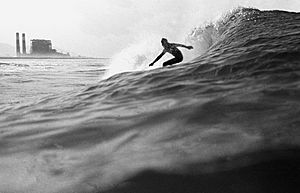
The Beach Boys' 1962 album Surfin' Safari had a funny description of surfing. It called it a water sport where you stand on a "floating slab of wood, resembling an ironing board." You try to stay standing while being "hurtled toward the shore at a rather frightening rate of speed." They joked it was "especially recommended for teen-agers... without the slightest regard for either life or limb."
Even with these media portrayals, true surfing culture kept changing. From the 1960s fad to the invention of the shortboard in the late 60s and early 70s. Then came the flashy surfing of the 1980s and the amazing professional surfing of the 1990s. This era was led by Kelly Slater, often called the "Michael Jordan of Surfing." In 1975, professional contests began. That year, Margo Oberg became the first female professional surfer.
Surfing documentaries have been key to how surfing culture grows. They show surfing not just as a sport, but as an art form. The style and quality of surf films often show how the sport has changed.
Professional Surfing
It's tricky to define professional surfing. Like many extreme sports, there are different ways to be a professional. Today, surfers mainly make money in three ways: sponsorship, surf contests, and social media influence. Often, professionals do all three.
If a professional surfer is someone who earns money from surfing, then professional surfing started around 1959. That's when the first West Coast Surfing Championships were held in Huntington Beach, California. Before that, there were many amateur contests. Ancient Hawaiians even bet on outcomes. Early contests were often races, starting from shore, paddling to a buoy, and riding a wave back.
In 1961, the United States Surfing Association (USSA) was founded. This was one of the first groups for professional surfing contests. Around this time, surfing changed. It went from just riding a good wave to focusing more on style. Turns, tricks, and artistry became important. Dynamic moves like nose-riding and cut-backs became more valued. Before, the main goal was just catching the best wave and riding it longest.
For many years, very few people made a living just from surfing. This changed in the 1970s. Much of the fame and money from contest surfing was in Hawaii. Specifically, the North Shore of Oahu became a key spot for performance surfing. But when Australians and South Africans joined Californians there, tensions grew. This was between Americans and international surfers, and even more, between local Hawaiians and outsiders.
In the 1980s, surfing gained wider popularity again (the first time was with Gidget). New bright colors, better shortboard performance, and more professional surfers appeared. Many surf brands like Town & Country Surf Designs and Body Glove became trendy. Pro surfers in the 1980s could earn more money and get more attention. They could often live without another job, just from contest surfing and sponsorships.
In recent decades, fewer than 60 men and 30 women qualify for the highest level of the surf league each year. This is the WSL. Thousands more surfers compete in smaller contests around the world. Most of these are for groms (young surfers). In the last 50 years, almost all professional surfers learned as children. They were often child prodigies, like in most modern professional sports.
In 1920, Duke Kahanamoku suggested surfing be in the Olympics. Surfing was supposed to be in the 2020 Tokyo Olympics for the first time. This would let athletes from around the world show their skills. But the COVID-19 pandemic caused the 2020 Games to be canceled. They were rescheduled for 2021. Surfing appeared in the 2021 Olympics at Tsurigasaki Beach in Chiba, Japan.
Surfing Technology and Boards
Surfing has always been open to new technology. There are no strict rules for surfboard design. Changes have happened often. Surfers choose styles and materials based on how they perform, how they feel, and their price. Surfboard shapers can be big brands, local artists, or even hobbyists. Unlike many sports, the surfboard's design differences are key to surfing's history and experience.
Much of surfing's modern history is defined by new technology. This often changed the experience completely. Surfers themselves have often created or changed technology. This helped them reach waves and places that were previously impossible to surf. Also, other gear became almost as important as the surfboard itself. A great example is the wetsuit. Surfing history could be split into "before wetsuits" and "after wetsuits." Wetsuits allowed surfing in places that were too cold before. This opened up huge amounts of un-surfed coastline worldwide.
Similarly, surfing history could be divided by "before polystyrene" and "after polystyrene" surfboards. Or "before fins" and "after fins." Original Hawaiian boards didn't have fins until Tom Blake added one in 1935. Technology has changed surfing many times. It generally made the sport more accessible, cheaper, easier, and improved performance.
Early on, surfing was mostly a warm-water sport, or only done in summer. It was also mainly a developed-world sport. This limited where it could be done. But after mass-produced fiberglass boards, good wetsuits, off-road vehicles, and cheap international travel, surfing became possible in many new coastal areas. Travelers introduced the sport and equipment to local people in even very remote places. By the 21st century, most of the world's coastlines have been explored. People surf in almost every country with waves.
The Short Board Revolution
Ancient Hawaiians had three main types of boards: Olo, Alaia, and Paipo. The Olo was 4.5 to 6.096 m (10 to 20 ft) long and made of solid wood. They were hard to make and only for the upper classes. The Alaia was only 1.82 or 2.13 m (5 or 5 ft) long and much thinner. The Paipo was even smaller, like a modern bodyboard. None of these had a fin.
For the first half of the 20th century, most modern surfboards were longboards. They were usually 2.74 m (10 ft) or longer. But after the 1930s, they started to change. They moved from solid, heavy wood to lighter materials like balsa wood. Today, they are mostly made of different types of polystyrene.
Over the years, shapers sometimes made smaller boards. These were often experiments or for smaller people. But these designs didn't become popular quickly. In the 1960s, surfboard production boomed. Shapers, mostly men, sometimes made smaller boards for girls. Girls are often lighter and shorter, which affects board needs. But shapers often ended up surfing these small boards themselves. This was because the surfing style was different, and mid-wave turns were becoming popular. Shorter boards made these turns easier.
Longer, thicker boards generally paddle faster. Paddle-speed is very important for catching waves. But in the 1960s, faster waves became more popular. These waves had narrower take-off zones and needed more skill to catch. If a surfer could catch a fast wave, a shorter board was easier to move. This also made it more fun.
By the early 1970s, shorter boards became very popular. They were not just novelties but full-time boards. So, new designs quickly followed. People experimented with the number and placement of fins. Different nose and tail shapes were tried. By the 1980s, these styles were refined. The modern shortboard took shape just as surfing became popular again. The 3-fin, 1.82 m (5 ft)-tall "thruster" shortboard became the most popular design. It was a generally narrow board with little design variation. It almost always had three fins, a pointed nose, a squash tail, and was about the height of the rider.
This basic board style, with small changes, has been the main type since the 1980s. It is still what a modern professional surfboard looks like. In 21st-century professional surfing, boards have slowly become shorter and wider. They have more rounded noses and sometimes four fins (very rarely two, never one). However, non-professionals still use all these options based on what they like.
Big Wave Surfing
Ancient Hawaiian surfers rode large, unbroken ocean swells on their Olo boards. But surfing a breaking wave taller than 4.5 to 6.1 m (10 to 20 ft) was extremely hard with old equipment. It might not have even been tried. But once board design improved quickly in the 1950s and 1960s, these bigger, faster waves became more accessible. The first truly famous big wave spot was Oahu's Waimea Bay.
As the North Shore of Oahu was explored, Waimea was seen as too fast and difficult. The movie Riding Giants tells how the first successful attempt was in October 1957. Once Waimea was surfed, it led to a search for other giant waves worldwide. A special group of surfers who loved riding very large waves emerged. By the 1990s, many giant waves were being surfed around the world. Some regularly reached 12.2 to 18.3 m (40 to 60 ft) (40, 50, even 60 feet).
Big wave surfing split into two main types: paddle-in and tow-in. Some waves are so big and fast that it's almost impossible to paddle fast enough to catch them. So, surfers started being towed by boats or personal watercraft (PWCs) to catch the wave.
Surfing for Fun and Meaning
"What is the point of surfing?" This question has been debated a lot within and outside of surf culture. Often, people in the media saw surfing as a waste of time or something lazy people did. Mostly, surfing is agreed to be purely for fun. It didn't start as, or become, a useful way to travel every day.
The types and sizes of waves vary a lot, as do surfboards. Even the "medium" can change. The simplest definition of surfing is using a wave's power to travel. So, in popular culture, the word "surfing" is often used for other things. "Surfing the web" and "couch surfing" are common examples. Characters like The Silver Surfer have even brought the idea of surfing into science fiction.
Some people also see surfing in a religious way. For ancient Hawaiians, this was important because they saw the ocean as a god. Even in modern surfing, it's common for surfers to call it a form of "church" or "mass."
Surfing Without Ocean Waves
Since they were invented, surfers have sometimes used wave pools to try surfing. But usually, the waves were too small and not well-formed enough to be fun. The 1987 movie North Shore started its main character in an Arizona wave pool. Then he went to Hawaii to try his luck. Both in and out of the movie, this was seen as a joke.
But more recently, many attempts have been made to build wave pools just for surfing. As of 2023[update], there are only a few open to the public worldwide. But many more are being developed. 2018 was the first year a professional surfing contest was held at a wave pool. This was at Kelly Slater's Surf Ranch.
Wakeboarding is a popular type of surfing done behind a boat's wake. Sometimes, there are also standing waves in rivers when the water flows fast. These can be surfable. At certain times of the year, on large rivers, tidal bores can be surfed. People have also surfed next to large cargo ships as their wakes roll into shallower water. A few people have even surfed waves caused by glaciers breaking apart. The Wave Bristol opened in the UK as an inland artificial surf site.
|
See also
 In Spanish: Historia del surf para niños
In Spanish: Historia del surf para niños


